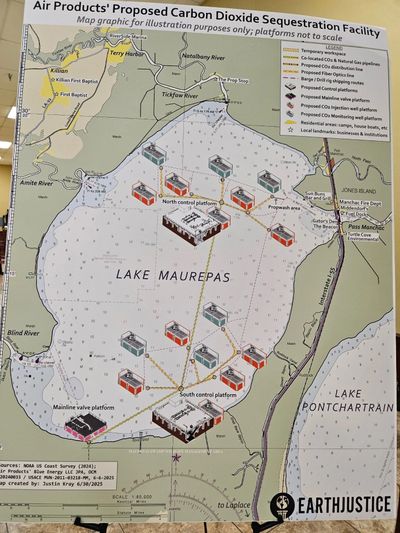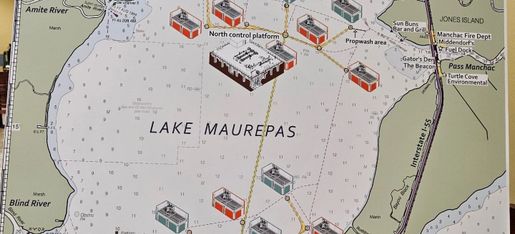The proposed plan
Air Products Proposed Carbon Dioxide Sequestration Facility
Air Products is full steam ahead in its pursuit of an Army Corps Clean Water Act section 404 permit and Louisiana Coastal Use Permit that would allow for the construction of a huge carbon sequestration facility that would spread throughout much of Lake Maurepas and operate for 25 years or more. Even though Air Products announced plans to sell off the carbon dioxide component of its proposed project and has halted new spending, it is pushing to secure permits so that it can attract a buyer to take over the carbon dioxide pipeline and sequestration facility.
If Air Products gets the permits for its planned carbon sequestration facility, it will be authorized to build a 24-inch pipeline that would carry pressurized carbon dioxide from its proposed plant in Ascension Parish to wells for injection and storage deep beneath Lake Maurepas. Nineteen platforms with wellheads or other infrastructure would be spread throughout the lake, connecting to a network of pipelines and cables buried under the lake bottom. Construction would greatly interfere with navigation and enjoyment of the lake. It would stir up and potentially re-suspend heavy metals and other contaminants in the sediment, which could impact water quality and harm crabs, fish, and other aquatic life, such as the West Indian Manatee observed in the lake. The facility would permanently scar this sacred place and could negatively affect area home values and businesses that thrive off the current uses of the lake.
The Lake Lake Maurepas is a roughly 93-square mile shallow, brackish, tidal estuarine lake that averages 9-10 feet deep. It is part of the Lake Pontchartrain Basin and is connected to Lake Pontchartrain via Pass Manchac. It is fed by four rivers: the Tickfaw, Blind, Amite, and Natalbany rivers. The lake is primarily surrounded by one of the largest forested wetlands in the nation, dominated by cypress-tupelo. Lake Maurepas is cherished for its unspoiled beauty. It is a vital resource for recreational activities like fishing, boating, kayak tours, wildlife observation, and photography, among other things. Lake Maurepas sustains commercial fishing, seafood retailers, restaurants, bars, marine businesses, ecotourism, and even the Tickfaw 200, the state’s largest power boat charity run.
Many people have built homes and camps in the area to enjoy the scenic beauty of Lake Maurepas. People who live in the subdivisions along the Tickfaw, Blind, and other rivers have easy access to the lake by boat. The Project The carbon dioxide pipeline, along with a co-located gas pipeline, would enter Lake Maurepas from a main valve platform (45 x 45 feet) at the south shore and run under the lake bottom for 10 miles to two large 100 x 75 feet control platforms that would tower 19 feet above the lake surface. More pipelines would be buried below the lake bottom to distribute carbon dioxide from the control platforms to 10 separate injection wells for storage deep beneath the lake. The injection wells would sit on dedicated platforms. Additionally, fiber optic cables would span from the control platforms buried six feet beneath the lake surface to six more platforms that would house other wells to monitor the carbon dioxide plume deep beneath the lake bottom. The injection and monitoring well platforms would be 20 x 8.5 feet, and 8 feet above the water surface. A lay barge with a 300-foot workspace would be equipped with high-pressure jets to excavate the lake bottom to carve trenches 6 feet deep and lay pipelines and fiber optic cables. Over 180,000 cubic yards of lake sediment would be excavated and dispersed into the water before settling back to the lake floor. A turbidity curtain may be utilized to help confine the sediment to the trenched areas, but very fine sediments could be transported far from the excavation area before eventually settling back to the lake bottom. A second barge also with a 300-foot workspace may be used for mechanical trenching where obstructions such as stumps and roots exist. A drill barge would be used at the injection well platforms. The injection well platforms and monitoring well platforms (16 in total) would each have a 265 x 70-foot rock pad on the lakebed. Nearly 29,000 cubic yards of lake bottom would be excavated for the rock pads and about 77,000 cubic yards of limestone would be dumped into the lake to form the rock pads. The south test well already constructed may be converted to a monitoring well. Concrete pile foundations would be constructed to support these platforms. Prefabricated decks and equipment would be brought to the platform sites and installed, “using any necessary barges or vessels for delivery and installation.” Following installation of the platforms and primary facilities, associated equipment, piping, and electrical systems would be installed. The Impacts Air Products claims that the wells would be in remote areas of the lake away from primary channels, but boaters and others use all areas of the lake. Construction activities could take well over a year or longer given the project delays already experienced, and the permanent surface and subsurface infrastructure such as the well platforms would create significant navigational obstructions and safety hazards. Air Products’ lease with the state allows it to enclose its carbon dioxide injection well sites and other portions of the facility “as may be required by applicable Sequestration Protocols.” It is not clear how much of the lake could be off-limits to the public. While Louisiana statute (La. R.S. 30:127.G) requires the lessee of state lands to allow public access to public waterways, the statute also gives the state the authority to restrict access to public waterways if it is determined that “a danger to the public welfare exists.” Air Products admits that the platforms, wellheads, and other lake infrastructure would be visible to lake users but claims “these features would have limited visibility to the public due to their remote locations.” But in fact, platforms and wellheads would not be in remote areas of the lake and would be visible for miles, spoiling views—including from Highway 51 and I-55. The construction and infrastructure throughout the lake would reduce the appeal of living along the lake or in the many subdivisions established along the rivers, which provide easy access to the lake. Property values in these communities could plumet if the lake is no longer a haven for boaters. Construction would resuspend and disperse fine sediments into the water. Fine sediments absorb contaminants including heavy metals. When these fine sediments are resuspended, the heavy metals can be released into the water, potentially affecting aquatic organisms—especially those that live on or near the lake floor such as crabs. The resuspension of heavy metals into the water leads to bioaccumulation, which is the buildup of chemicals including heavy metals in the tissues of organisms. For instance, the existing heavy metals like mercury, arsenic, cadmium, and lead can accumulate in fish tissues, and when consumed by humans can lead to various health problems. For this reason, the sediment should not be disturbed. A pipeline rupture in the lake could lead to the release of large volumes of high-pressure carbon dioxide in the lake, and depending on the magnitude of the rupture, could be detrimental to aquatic organisms and anyone fishing or recreating in the area. A major carbon dioxide release from an injection well (for example, a well blowout) could be devastating and even life-threatening. While there are little to no studies on the effects of a carbon dioxide leakage over time from a pipeline or sequestration facility in a lake, there is ample research and scientific consensus on the negative impacts of acidification of water bodies from excess carbon dioxide intake, such as loss of biodiversity and decline in numbers of fish and other aquatic organisms.

This website uses cookies.
We use cookies to analyze website traffic and optimize your website experience. By accepting our use of cookies, your data will be aggregated with all other user data.

SIGN THE PETITION!
Sign the Petition to stop the carbon capture in our beautiful Lake Maurepas!